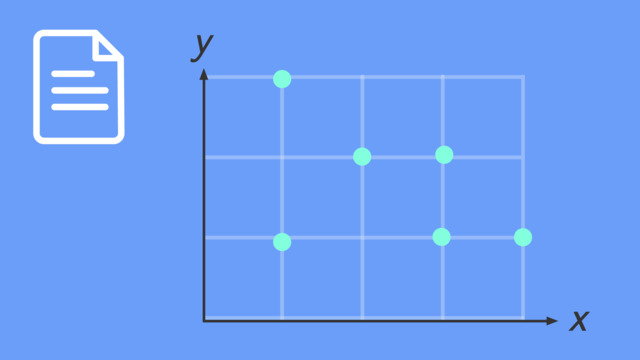Fractions on Line Plots
Learning text on the topic Fractions on Line Plots
Line plots with fractions are a type of graph that shows data on a fractional number line. There are crosses created above the line to indicate the frequency of each unit of data.
Line Plots with Fractions – Example
In this example, we want to look at how much snow fell on different days. We have given data and the question is “What was the least amount of snow accumulated in a day?” With the help of using line plots, we can answer questions about the data.
Our line does not indicate the fraction for the day with the least amount of snow, so we need to count how many increments the line is divided into. The line plot is divided into eighths, so the denominator of our fraction will be 8. Our date is on the first increment on the line plot. The position of the increment is the numerator of the fraction we want to find out. Combining our data, we see that numerator 1 and denominator 8 are the fraction $\frac{1}{8}$, so the least amount of snow fallen in a day is $\frac{1}{8}$ feet!
If the question now commands us to find the greatest amount of snowfall accumulated in a day, we look at our line plot again and search for the rightmost entry on the line.
Using our counted increments from earlier, we see that the greatest amount of snowfall in a day accumulated up to $\frac{7}{8}$ feet of snow!
Line Plots with Fractions – Summary of Steps
When asked to answer questions using line plots with fractions, follow these steps:
| Step # | What to do |
|---|---|
| 1 | Look at the data on the line plot to understand what you need to find. |
| 2 | If the line does not indicate the fraction you are looking for, count the number of increments on the line plot. |
| 3 | The number of increments total is the denominator and the specific increment is the numerator of your fraction. |
Line Plots with Fractions – Further Practice
Have a look at our interactive exercises and worksheets which will provide you with continued practice using line plots to record data and answer questions about the fractional data.
Fractions on Line Plots exercise
-
How do we answers questions about fractions on a line plot?
HintsThe data needs plotting first before any further steps.
Read the question before counting.
Solution- Plot data on the line plot.
- Read questions and identify keywords that tell you what to look for on the line plot.
- Count how many increments the line is divided into if the fraction is not listed on the line plot.
- Simplify fractions as necessary.
-
What was the greatest amount of snowfall accumulated in a day?
HintsWhat does greatest amount of snow accumulation mean?
We are not looking for the most frequent amount of snow.
Which fraction on the line plot represents the most snowfall accumulation?
Fractions with the same numerator and denominator are equal to 1.
Solution- The greatest amount of snowfall accumulated in a day was $\frac{8}{8}$.
- $\frac{8}{8}$ is simplified to 1.
- The answer is 1 foot.
-
Find the difference.
HintsWhat does difference mean?
To find the difference, subtract the lowest (or least) amount from the greatest amount.
$\frac{1}{8}$ is the lowest amount and $\frac{8}{8}$ is the greatest amount.
Solution- Difference means to subtract, so you need to find the fractions on the line plot that represent the least and greatest amount of snowfall accumulation and subtract them.
- $\frac{1}{8}$ is the least.
- $\frac{8}{8}$ is the greatest.
- $\frac{8}{8}$ - $\frac{1}{8}$ is $\frac{7}{8}$.
- The answer is $\frac{7}{8}$.
-
Combining fractions.
HintsSimplify the fractions on the line plot to work out which fractions are less than $\frac{1}{4}$.
When we combine we add.
There are two fractions that need adding together.
Don't forget to simplify your answer.
Solution- Combine means to add so you need to add the fractions that represent less than $\frac{1}{4}$ of a foot of snow on the line plot.
- $\frac{1}{8}$ is less than $\frac{1}{4}$ of a foot of snow.
- You add $\frac{1}{8}$ two times since there are two Xs above $\frac{1}{8}$ on the line plot.
- $\frac{1}{8}$ + $\frac{1}{8}$ = $\frac{2}{8}$
- $\frac{2}{8}$ is simplified by dividing the numbers by 2.
- The answer is $\frac{1}{4}$.
-
Can you complete the number line?
HintsWhich data point on the line plot illustrates e.g. the least amount of snowfall accumulation?
Which data point on the line plot illustrates e.g. the most amount of snowfall accumulation?
Look at the numerators to help you order the fractions.
SolutionThe image pictured illustrates the fractions in order from least to greatest on the line plot.
-
Can you solve the problem?
HintsWhat does combine tell you to do?
What does the difference tell you to do?
Don't forget to simplify your answer.
Solution- First, you need to find the combined amount for the days with less than a quarter of a foot of snow accumulation.
- Combine tells you to add.
- $\frac{1}{8}$ + $\frac{1}{8}$ = $\frac{2}{8}$
- Next, you need to find the difference in the amount of snow between the combined amount and the greatest.
- Difference means to subtract.
- $\frac{8}{8}$ - $\frac{2}{8}$ = $\frac{6}{8}$
- Finally, you need to simplify $\frac{6}{8}$ since 6 and 8 can be divided by 2.
- The answer is $\frac{3}{4}$.
 Do you want to learn faster and more easily?
Do you want to learn faster and more easily?



















